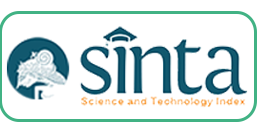EXPLORING THE SYNERGY BETWEEN SPOKEN AND WRITTEN TEXTS: INNOVATIONS IN ENGLISH LANGUAGE TEACHING STRATEGIES
Abstract
Keywords
Full Text:
PDFReferences
Amoia, M., Kunz, K., & Lapshinova-Koltunski, E. (2024). Coreference in spoken vs. written texts: A corpus-based analysis. Proceedings of the 8th International Conference on Language Resources and Evaluation, LREC 2012.
Aryati, K. F. (2023). The Impact of Merdeka Belajar Curriculum on English Language Teaching in International Institute of Business and Tourism. EDUKASIA: Jurnal Pendidikan Dan Pembelajaran, 4(2).
Bohmann, A. (2020). Situating twitter discourse in relation to spoken and written texts. Zeitschrift Fur Dialektologie Und Linguistik, 87(2). https://doi.org/10.25162/zdl-2020-0009
Bose, P., & Gao, X. (2022). Cultural Representations in Indian English Language Teaching Textbooks. SAGE Open, 12(1). https://doi.org/10.1177/21582440221082102
Boy Jon, R., Embong, R., Purnama, B., & Safar Wadi, A. (2021). The Challenges of English Language Teaching in Indonesia. International Journal of English and Applied Linguistics (IJEAL), 1(3). https://doi.org/10.47709/ijeal.v1i3.1157
Chicherina, N. V., & Strelkova, S. Y. (2023). Translanguaging in English Language Teaching: Perceptions of Teachers and Students. Education Sciences, 13(1). https://doi.org/10.3390/educsci13010086
Chordia, V. (2021). Punktuator: A multilingual punctuation restoration system for spoken and written text. EACL 2021 - 16th Conference of the European Chapter of the Association for Computational Linguistics, Proceedings of the System Demonstrations. https://doi.org/10.18653/v1/2021.eacl-demos.37
Daflizar, Indrayadi, T., & Irawan, Y. (2022). Unveiling Indonesian Pre-Service Teachers’ Perceived Competencies and Readiness for Online English Language Teaching: A Mixed Methods Study. Journal of Language Teaching and Research, 13(2). https://doi.org/10.17507/jltr.1302.21
Do, Q., & Hoang, H. T. (2023). The Construction of Language Teacher Identity Among Graduates from Non-English Language Teaching Majors in Vietnam. English Teaching and Learning. https://doi.org/10.1007/s42321-023-00142-z
Gunantar, D. A. (2016). The Impact of English as an International Language on English Language Teaching In Indonesia. LANGUAGE CIRCLE:Journal Lof Language and Literatur, X(2).
Hashim, S. N. A., & Mohd Yusoff, N. (2021). The use of reflective practice towards achieving effective english language teaching at primary schools. International Journal of Evaluation and Research in Education, 10(1). https://doi.org/10.11591/IJERE.V10I1.20956
Haswani, F., Baharuddin, & Simbolon, N. (2023). Multicultural Education in English Language Teaching: A Study of Paradigms, Perceptions, and Implementation Strategies. World Journal of English Language, 13(2). https://doi.org/10.5430/wjel.v13n2p424
Hazaea, A. N., Bin-Hady, W. R. A., & Toujani, M. M. (2021). Emergency remote english language teaching in the arab league countries: Challenges and remedies. CALL-EJ, 22(1).
Ihori, M., Sato, H., Tanaka, T., Masumura, R., Mizuno, S., & Hojo, N. (2023). Transcribing Speech as Spoken and Written Dual Text Using an Autoregressive Model. Proceedings of the Annual Conference of the International Speech Communication Association, INTERSPEECH, 2023-August. https://doi.org/10.21437/Interspeech.2023-1655
Iskandar, I., Sumarni, S., Dewanti, R., & Asnur, M. N. A. (2022). Infusing Digital Literacy in Authentic Academic Digital Practices of English Language Teaching at Universities. International Journal of Language Education, 6(1). https://doi.org/10.26858/ijole.v6i1.31574
Khan, N. M., & Kuddus, K. (2020). Integrating ICT in English language teaching in bangladesh: teachers’ perceptions and challenges. Rupkatha Journal on Interdisciplinary Studies in Humanities, 12(5). https://doi.org/10.21659/RUPKATHA.V12N5.RIOC1S23N1
Khansir, A. A., Dehkordi, F. G., & Mirzaei, M. (2021). Learning strategies and english language teaching. Theory and Practice in Language Studies, 11(6). https://doi.org/10.17507/tpls.1106.19
Kostka, I., & Toncelli, R. (2023). Exploring Applications of ChatGPT to English Language Teaching: Opportunities, Challenges, and Recommendations. TESL-EJ, 27(3). https://doi.org/10.55593/ej.27107int
Moorhouse, B. L., & Kohnke, L. (2021). Responses of the English-Language-Teaching Community to the COVID-19 Pandemic. In RELC Journal (Vol. 52, Issue 3). https://doi.org/10.1177/00336882211053052
Mubarok, H., Sofiana, N., & Mahendra, D. (2023). English Language Teaching In Indonesia; The Implementation Of Merdeka Curriculum In Senior High Schools. Journal of Namibian Studies, 35.
Nasution, J., Batubara, C., Ridwan, M., & Sadri, I. (2021). Sourcing the Academic Works for English References: An Analysis of Students’ Perceptions. KnE Social Sciences, 368-376Nguyen, L. T. H. (2021). Teachers’ Perception of ICT Integration in English Language Teaching at Vietnamese Tertiary Level. European Journal of Contemporary Education, 10(3). https://doi.org/10.13187/ejced.2021.3.697
Peng, N., & Chen, X. (2023). Model-based learning towards environment in cross-cultural communication: a mediating role of technology innovation acceptance in culture congruence and English language teaching for environmental education. Economic Research-Ekonomska Istrazivanja , 36(3). https://doi.org/10.1080/1331677X.2022.2162946
Rahman, M. M., Islam, M. S., Karim, A., Chowdhury, T. A., Rahman, M. M., Seraj, P. M. I., & Singh, M. K. M. (2019). English language teaching in Bangladesh today: Issues, outcomes and implications. In Language Testing in Asia (Vol. 9). https://doi.org/10.1186/s40468-019-0085-8
Rahmati, J., Izadpanah, S., & Shahnavaz, A. (2021). A meta-analysis on educational technology in English language teaching. Language Testing in Asia, 11(1). https://doi.org/10.1186/s40468-021-00121-w
Rashid, R. A. B., Rahman, S. B. A., & Yunus, K. (2017). Reforms in the policy of English language teaching in Malaysia. Policy Futures in Education, 15(1). https://doi.org/10.1177/1478210316679069
Rini, S. (2014). The Error Analysis on the Students of English Department Speaking Scripts. Register Journal, 7(2), 225. https://doi.org/10.18326/rgt.v7i2.225-244
Rodrigues, W., Albuquerque, F. E., & Miller, M. (2019). Decolonizing english language teaching for brazilian indigenous peoples. Educacao and Realidade, 44(2). https://doi.org/10.1590/2175-623681725
Sletova, N., & Isurin, L. (2023). Relationship between written and spoken text recall in L2. Foreign Language Annals, 56(1). https://doi.org/10.1111/flan.12642
Soler, A. G., Labeau, M., & Clavel, C. (2022). Polysemy in Spoken Conversations and Written Texts. 2022 Language Resources and Evaluation Conference, LREC 2022.
Swatevacharkul, R., & Boonma, N. (2021). Learner autonomy assessment of English language teaching students in an international program in Thailand. Indonesian Journal of Applied Linguistics, 10(3). https://doi.org/10.17509/ijal.v10i3.31764
Tarrayo, V. N., Potestades, R. R., & Ulla, M. B. (2021). Exploring the Gender Perspective in English Language Teaching (ELT): Voices from ELT Practitioners in Philippine Higher Education Institutions. Sexuality and Culture, 25(5). https://doi.org/10.1007/s12119-021-09840-x
Turan, Z., & Akdag-Cimen, B. (2020). Flipped classroom in English language teaching: a systematic review. Computer Assisted Language Learning, 33(5–6). https://doi.org/10.1080/09588221.2019.1584117
Waluyo, B., & Apridayani, A. (2021). Teachers’ beliefs and classroom practices on the use of video in english language teaching. Studies in English Language and Education, 8(2). https://doi.org/10.24815/siele.v8i2.19214
Yang, Y. (2020). A contrastive study of engagement resources between English spoken and written texts. Text and Talk, 40(6). https://doi.org/10.1515/text-2020-2075
Zhiyong, S., Muthukrishnan, P., & Sidhu, G. K. (2020). College english language teaching reform and key factors determining efl teachers’ professional development. European Journal of Educational Research, 9(4). https://doi.org/10.12973/eu-jer.9.4.1393
DOI: http://dx.doi.org/10.30829/vis.v21i1.4221
Refbacks
- There are currently no refbacks.
Copyright (c) 2025 VISION
















